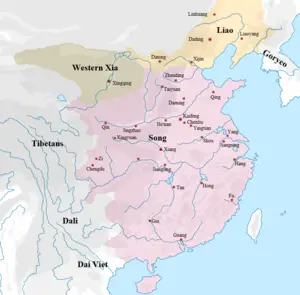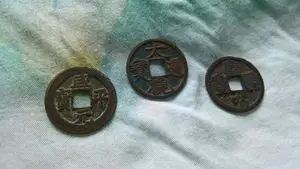Difference between revisions of "How Did the Creation of Paper Money during the Song Dynasty Impact China"
| Line 47: | Line 47: | ||
===References=== | ===References=== | ||
<references/> | <references/> | ||
| + | |||
| + | {{Contributors}} | ||
[[Category: Asian History]] [[Category: Chinese History]] [[Category: Economic History]] [[Category:Wikis]] | [[Category: Asian History]] [[Category: Chinese History]] [[Category: Economic History]] [[Category:Wikis]] | ||
Revision as of 23:01, 3 May 2019
Today, most people take the existence of paper money for granted and few know how its use originated and developed throughout history. In Western countries such as the United States, paper money has a relatively short existence going back to the seventeenth and eighteenth centuries, but in China paper currency first began circulating over 1,000 years ago.
The development of paper money was the result of a larger historical process whereby the leaders of the Song Dynasty (AD 960-1279) had to devise new ways to compensate for the demand in metal currency that was the result of their expanding economy. In the end, although the Song Dynasty collapsed for a variety of reasons, their use of paper currency was adopted by later Chinese dynasties, eventually spreading to other Asian peoples. Despite having a profound impact on Asian economic history, paper currency would be one of many inventions/discoveries that never left East Asia and was only discovered in Europe independently several centuries later.
The Song Economy
The Song Dynasty is generally divided by scholars into the Northern Song (960-1279) and the Southern Song (1127-1227), although the Chinese would have seen no such division at the time. The division was the result of pressures from militarily powerful enemies from the north who pushed the Song Dynasty further south, but for the most part, there was cultural and political continuity between the Northern and Southern Song. The Song came about after the Tang Dynasty, which had ruled over a unified China, collapsed in AD 907, ushering in a more than fifty year period of anarchy and political decentralization in China.
During the period of decentralization, five dynasties claimed power, one of which was known as the “Later Zhou.” In 960, the Later Zhou was led by a child emperor who was protected by a palace army led by a man named Zhao Kuangyin. After serving as a loyal commander for some time, Zhao Kuangyin decided he wanted to rule so he deposed the child emperor in 960 and was proclaimed by his followers as Taizu (reigned 960-976), the first of the Song emperors. [1]
Taizu set up the Song capital at Kaifeng, which is where it would remain until the collapse of the Northern Song. Although the Song had to contend with powerful and sometimes bellicose neighbors, it differed from many pre-modern Chinese dynasties because it deemphasized, or even eschewed martial culture. Song emperors placed the civil branch over the military, which was a direct byproduct of their stringent following of Confucian philosophy. The Song was also different from many previous Chinese dynasties in that merit was rewarded over nepotism: officials were chosen due to their knowledge of the Confucian canon, not their family connections. [2]
The Song leaders’ focus on merit proved to be beneficial to the long-term goals of the dynasty as a new era of innovation took place in China beginning in the late tenth century. The invention of the movable type press in the eleventh century, probably by a scholar named Bi Sheng, replaced the more cumbersome woodblock press. Song officials quickly learned that not only could the movable type press be used to quickly disseminate paper documents, but it could also be used to print notes of financial exchange, which eventually became the first paper currency. [3]
The Transition to Paper Currency in China
During the Qin (221-206 BC) and the Han (206 BC-AD 220) dynasties that preceded the Song, the standard currency used was known as the guan. One guan usually equaled 1,000 round bronze coins with square holes that were threaded on a string as a full unit, or “string,” [4] As the Song economy flourished, more and more copper strings were in circulation throughout the empire. The number reached 1.83 million strings in 1007 and five million by 1080, leading officials to add lead to the coins, which devalued the currency. [5] Song economists knew that they could not further devalue the metal currency without adversely affecting the economy, so they developed the idea of paper currency.
Although paper currency was first introduced by the Song emperors, there are no extant examples. The development of paper currency came about quite naturally and was the result of high demand for bronze, copper, and iron, which were all used to make coins of various denominations. Along with the diminishing supply of metals used for currency, Chines scholars developed the new economic idea that held paper money as a means of payment and exchange, not as a value in itself. [6]

The issuing of paper currency in Song China was as much of a process as the invention of paper currency itself. There was no single currency until the end of the dynasty, but instead, there were several currency zones throughout China. The first paper currency used was the jiaozi, which was first issued in Sichuan. [7] The use of the jiaozi proved to be quite successful, leading to the creation of numerous other paper currencies, the most widespread of which was the huizi.
The huizi was a paper bill that became the standard currency of the Southern Song in 1160. At first, one huiz equaled one “string,” but after awhile smaller dominations were created of 200, 300, and 500 coins strings. [8] The Song’s use of the huizi was accompanied by two major details that were intended to make the bill enduring.
The first policy that the Southern Song rulers enacted concerning the huiz was mandating fixed terms of expiration. Between 1168 and 1264 the Southern Song emperors issued eighteen new huizi bills, primarily to mitigate counterfeiting, but also to control inflation. [9] Routinely destroying the old notes certainly helped the Song rulers avoid economic problems, which was also helped by their linking the paper currency to silver.
Today, paper currency is not “backed” by gold, but for most of human history gold and silver were the value backing most national currencies. In Song China, as the number of bronze coins began to diminish, the paper notes eventually became linked to silver as the hard currency backing the paper money. After 1160, the huizi was denominated in bronze coin strings, but backed by silver. [10] Although the creation of paper currency was truly revolutionary and proved to be a medium-term boon for the Song economy, its misuse proved to be one of the final nails in the Southern Song’s coffin.
The Song’s issuance of paper currency worked well for nearly 100 years, but after awhile China was faced with the same economic problem as the Romans before them and countless later countries – inflation. There were an estimated 650 million strings on the market in 1246, which led to an extreme devaluation of the huizi and eventually runaway inflation. The Song leaders made the same mistake as other world leaders have in similar situations by printing more and more money, which only aggravated the inflationary cycle. The Song paper currency collapsed in 1264 and the dynasty itself was wiped out just fifteen years later. [11] Whether the inflationary cycle was a symptom or one of the reasons for the Southern Song’s demise is open to argument, but there is no argument that it did not help the overall situation – the Song leaders could no longer pay to field armies nor could they pay annual tribute to their more martial-minded neighbors in the north.
The Impact of Song Paper Currency
Related Articles
- What did the China Ambassadorial talks of 1955 accomplish
- Why did the Carter Administration establish official diplomatic relations with the People's Republic of China in 1979
- What did the Open Door policy with China Accomplish
- Why did the Treaty of Wangxia negotiated with the United States ultimately alienate China
The impact of the invention/discovery of paper currency during the Song Dynasty was profound to say the least. Although the concept never made its way to the West, it indeed spread throughout east Asia during the Middle Ages. The Jurchen Jin Dynasty, which ruled northern China from 1127 to 1234, issued paper notes in the mid-1150s based on the notes the Song rulers originally issued in Sichuan and later issued other notes that were tied to silver, as the Southern Song had done. [12]
The Song was replaced by the Mongol Yuan Dynasty and although foreign, the Yuan instituted a policy of cultural continuity, which included the use of paper money. Like the Jurchen Jin Dynasty, the Yuan rulers followed the Southern Song policy of tying their paper currency to silver. [13] From China, the concept of paper money spread to other East Asian kingdoms such as Korea.
Perhaps one of the biggest impacts that the invention of paper money had in Asia was the diminishing value of bronze, copper, and iron coins. Once the Southern Song tied their paper notes to silver, the intrinsic value of metal coins declined, which resulted in much of those metals being exported to Japan. [14] In fact, the use of paper currency in China hurt the metals industry in general as mining withered during the Southern Song. [15] The Song discovery of paper currency truly had a great impact on East Asia, but it would be centuries before Europeans discovered the benefits and drawbacks of using paper notes.
References
- ↑ Kuhn, Dieter. The Age of Confucian Rule: The Song Transformation of China. (Cambridge, Massachusetts: The Belknap Press of Harvard University Press, 2009), p. 19
- ↑ Kuhn, pgs. 31-39
- ↑ Kuhn, p. 43
- ↑ Glahn, Richard von. “Monies of Account and Monetary Transition in China, Twelfth to Fourteenth Centuries.” Journal of the Economic and Social History of the Orient 53 (2010) p. 465
- ↑ Kuhn, pgs. 233-4
- ↑ Kuhn, pgs. 234-6
- ↑ Glahn, Richard von. “Re-examining the Authenticity of Song Paper Money Specimens.” Journal of Song-Yuan Studies 36 (2006) p. 80
- ↑ Kuhn, p. 239
- ↑ Glahn 2006, p. 81
- ↑ Glahn 2010, p. 466, 501
- ↑ Kuhn, p. 241
- ↑ Glahn 2010, p. 469, 472
- ↑ Glahn 2010, p. 483
- ↑ Glahn 2010, p. 501
- ↑ Smith, Paul J. “Do We Know as Much as We Need to Know About the Song Economy? Observations on the Economic Crisis of the Twelfth and Thirteenth Centuries” Journal of Song-Yuan Studies 24 (1994) p. 329


